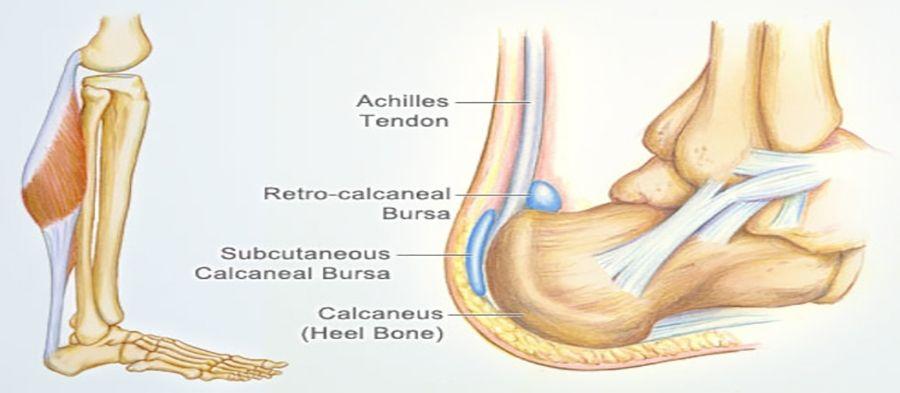The gastrocnemius and soleus muscles (calf muscles) unite into one band of tissue, which becomes the Achilles tendon at the low end of the calf. The Achilles tendon then inserts into the calcaneus. Small sacs of fluid called bursae cushion the Achilles tendon at the heel.
The Achilles tendon is the largest and strongest tendon in the body. When the calf muscles flex, the Achilles tendon pulls on the heel. This movement allows us to stand on our toes when walking, running, or jumping. Despite its strength, the Achilles tendon is also vulnerable to injury, due to its limited blood supply and the high tensions placed on it.
Achilles Tendon Sympton
The most obvious sign is pain above your heel, especially when you stretch your ankle or stand on your toes. It may be mild and get better or worse over time. If the tendon ruptures, the pain is instant and severe. The area may also feel tender, swollen, and stiff.
You may feel pain or swell at lower of small leg.
If your Achilles tendon tears, you may hear a snapping or popping noise when it happens. You could have bruising and swelling, too. You also may have trouble pointing your toes and pushing off your toes when you take a step.
Achilles Tendon Conditions
- Achilles tendon tear: Tears of the Achilles tendon can be tiny (microtears), or large, causing pain, swelling, and impaired movement. They may occur suddenly during activity, or gradually over time.
- Achilles tendon rupture: A complete rupture of the Achilles tendon may make a "pop" sound, followed by pain and swelling of the lower leg. Treating an Achilles tendon rupture requires surgery or long-term immobilization of the ankle.
- Achilles tendinitis (tendonitis): Frequent activity (running or walking) can gradually inflame the end of the Achilles tendon, causing pain and stiffness at the back of the heel. Rest, ice, and stretching may speed healing, which can take weeks.
- Achilles peritendonitis: Similar to Achilles tendonitis, but inflammation and pain occur in the tissue surrounding the tendon, often two or more inches above the heel.
- Achilles tendinosis: Gradual thickening of the Achilles tendon without apparent inflammation, due to aging or overuse. Despite the thickening, the tendon is weakened and prone to further injury or rupture.
- Achilles tendinopathy: A general term for tendinitis or tendinosis affecting the Achilles tendon.
- Achilles or heel (calcaneal) bursitis: Low-riding shoes can irritate the bursa, a sac of fluid cushioning the Achilles tendon at the heel. Pain in the back of the heel, worse with shoes on, is the common symptom.
Achilles Tendon Treatments
- RICE therapy: Most Achilles tendon injuries can be treated with RICE: Rest, Ice, Compression with a sports bandage, and Elevation.
- Pain relievers: Over-the-counter medicines like acetaminophen (Tylenol), ibuprofen (Motrin), and naproxen (Aleve) can lessen the pain of most Achilles tendon problems. For more severe pain, prescription pain relievers may be necessary.
- Heat: Alternating ice and heat therapy may improve the pain of bursitis near the Achilles tendon.
- Footwear: Wearing shoes with good support that are right for your feet may help avoid continual injury to the Achilles tendon. Custom-made orthotics, heel lifts, and certain splints and braces are sometimes helpful.
- Physical Therapy: Although modifying or decreasing activity is important, particular stretches and exercises may be helpful to rehabilitate tendon problems, especially when they are persistent.
- Immobilization: Many moderate to severe Achilles tendon conditions require immobilization of the ankle joint. This may require wearing a special boot or a leg cast for several weeks.
- Achilles tendon surgery: Surgery can often reattach a ruptured Achilles tendon. Following surgery, immobilization of the ankle is necessary for several weeks.

